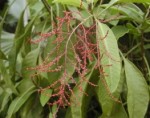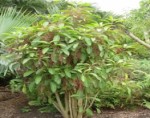Scientific Name: Charpentiera obovata
Also Known As: Hawai’i’s Pyrotechnic Plant
Endemic: O’ahu, Moloka’i, Maui and Hawaii island
Description: Exotic looking shubs to medium sized trees up to 15 feet tall with large elliptical leaves that are easily distinguished by their pronounced marginal rib that encompasses the entire leaf perimeter. Foliage color is usually light green but often new shoots can be reddish-pink. The veins of the leaves can be varying hues of green, cream and yellow or sometimes even maroon, pink and or purple. The flowers are very small and emerge on a hanging inflorescence that can also vary in color from yellow to dark red and is usually 12-18 inches long. The foliage and flowering characteristics of this plant make it look very unusual and is a definite attention getter for any yard.
Distribution: The genus Charpentiera is comprised of six species, five of which, including this one, are found in Hawaii and no where else in the world. This particular species is very widespread and occurs in the mesic and wet forests of O’ahu (Ko’olau Mts. and Wai’anae Mts.), Molokai, Maui and Hawai’i. These plants are usually a component of the understory shrubbery but large specimens will reach the canopy in some areas and be exposed to full sun conditions.
Cultural Use: The dried wood of this plant is very light and flammable and it was used as fireworks. Hawaiians would ignite the wood and throw them off of cliffs leaving a trail of fire as it fell.
Landscape Use and Care: Papala is ideal for anyone who needs a taller tree for a shadier location. It also does fine in the full sun and can even handle short periods of drought but prefers a somewhat regular watering schedule. I’ve planted them under larger Koa trees and under the eves of houses and they do great. They also do well in pots for inside your home. As far as pests are concerned the only one that you should be on the lookout for is scales, especially the big brown domed shaped type. These are usually associated with ants that bring them to the plants so be sure to treat the ants as well as the scales to prevent an endless battle.
Additional Info: Do not get this plant, Papala, confused with another native plant called Papala kepau (Pisonia sp.). They are in no way related. Papala comes from the Amaranth family (Amaranthaceae), is related to other plants like kulu’i, Achyranthes and Amaranth, and is used for pyrotechnic displays while papala kepau is in the Four-o’clock family (Nyctaginaceae) and is used to catch birds.
Papala









